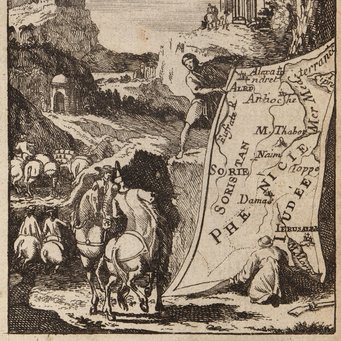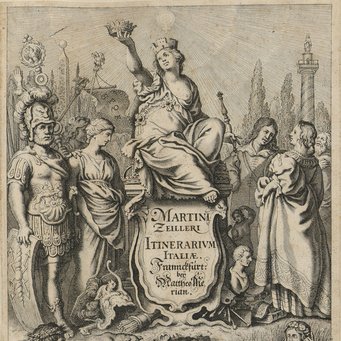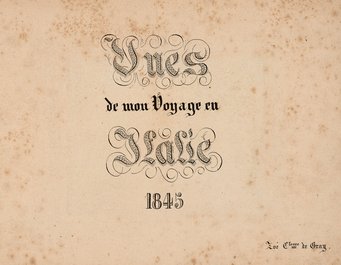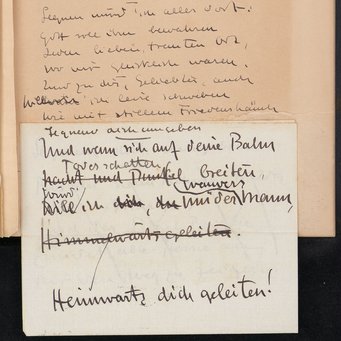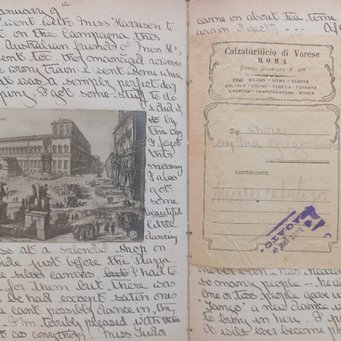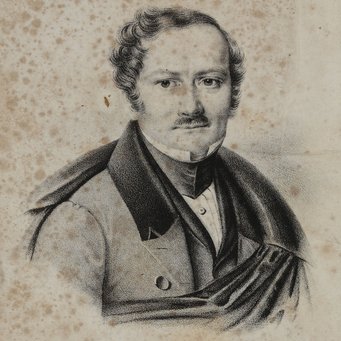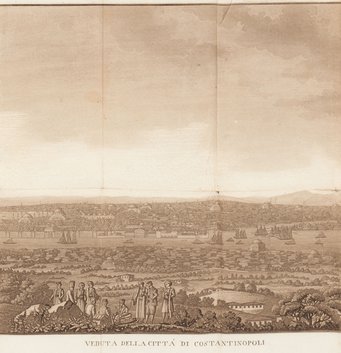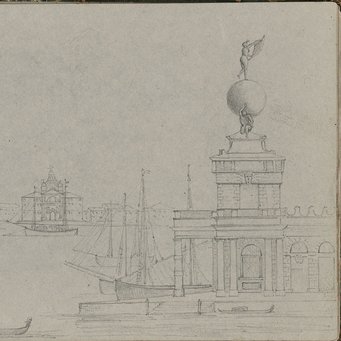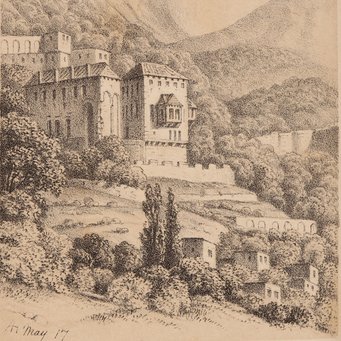Travel Literature

The Bibliotheca Hertziana has one of the best collections of travel literature about Italy. This, as well as the collection on travel to other destinations is constantly being enlarged, with the eastern Mediterranean forming a further focus. In the shelfmark groups Fa (journeys to Italy) and Ff (to all other countries), these publications are arranged chronologically according to the date of the journey. Travel literature refers to published diaries, correspondence, and memoirs, which may consist of pure text with or without illustrations, but may also consist of purely illustrated volumes: Ancient sites, natural wonders, city vedutas as well as customs and traditions stand side by side here. Over the centuries, the establishment of travel routes, canonical sights and patterns of perception can be traced, as well as the change in the sociological milieu of the travelers themselves. The printed works also document the development of editorial standards and strategies.
The publications were produced in connection with educational travel (Grand Tour), ethnological and natural history interests, but also military or politically motivated travel (for example, in connection with colonialist endeavors), with the radius increasingly expanding from Europe and the Orient to America. Many of these publications can be found using search terms such as “Reiseliteratur” (travel literature), “Reisebericht” (travel report), or „Reiseführer” (travel guide) in combination with the country of interest.
Ff 140-3060 raro II
Travel to Italy

Martin Zeiller (1589–1661), a German polyhistor distinguished by his great literary productivity, author of travel manuals and encyclopaedias, traveled to Italy in 1628–1629. This work contains descriptions of various travel routes from Germany and France to Italy and historical information, partly from his own experience and partly taken from other authors. The frontispiece is signed by the German engraver and art theorist Joachim Sandrart (1606–1688). The Hertziana owns two copies: one with all the maps and copper plates, and a second that has been completely plundered, as so often happens with engravings that sell well.
Fa 150-2400 raro IV

The album with city and landscape views bears the title “Vues de mon voyage en Italie 1845” and the name “Zoë C.tesse de Gray” on the first page. However, with 19 sheets, the journey to Italy only takes up a small part; these sheets are followed by a section introduced as “Voyage de Caroline en 1852 – juillet et août” and containing motifs from France, Switzerland and Belgium, introduced by. Naples and Pompei take up a large part of the views from Italy. In addition to the commercial prints sold to tourists, there are also some handmade gouaches, as they were offered to travelers as souvenirs. The glued-in pictures thus document a pre-photographic picture market that was established in the course of the tourism that emerged from the Grand Tour.
Fa 230-4524 raro VII

Olga von Gerstfeldt (1866–1910), writer and art historian, married the art historian Ernst Steinmann (1866–1934) in 1901, who later became the first director of the Bibliotheca Hertziana. In the year of her death, the book Pilgrimages in Italy, a compilation of poems and essays, was published together with her husband . It went through three editions up to 1914, the fourth, expanded with numerous photographs, was published in 1922. The Hertziana owns several copies, three of which document the revision process by Ernst Steinmann by means of handwritten entries and supplements. This copy here also contains an ownership note, which in turn documents a process of creation: It is the bookplate designed by German artist Marcus Behmer (1879–1958), of which the library owns a signed copy dated September 1912 (K-STE 3539-5120 raro IV). Here, however, it appears in a version in which the three stalks of barley (in German Gerste, thus alluding to the surname) in the center of the pyramid flanked by cypresses and the names Ernst Steinmann and Olga von Gerstfeldt below are missing.
Fa 300-5105/f raro IV

This capacious volume is a travel diary in which images and texts of various kinds – mainly postcards and tickets – are pasted into the text as the journey progresses. The author is probably identical to the addressee of several postcards, Vera Shore. The young woman describes the journey with her family – whom we get to know as Mother, Daddy, Dolly, Joyce and Lorna – from Munich via Venice, Padua, Assisi and Perugia to Rome. They were stationed here from November 5, 1912 to February 16, 1913, including excursions to the surrounding area such as Tivoli and Bracciano. In addition to visiting the monuments, we also learn a lot about everyday life: for example, about their search for accommodation, which led them to “such a nice flat” at Via Gregoriana 54, about social events, such as an invitation to a dance or to a charity event organized by an animal welfare association, but also about the collapse of a house between Via Capo le case and Via Sistina on January 8, 1913, which claimed many lives. The diary concludes with the author remarking how she forgot to throw a penny into the Trevi Fountain: “How silly of me!”
Fa 300-5136 raro V

Gustav Alexander Wilhelm Nicolai (1795–1868), writer and composer, undertook a fifteen-week trip to Italy with his family in 1833 – at first probably enthusiastically, like many of his contemporaries who set off driven by a longing for Italy. However, he soon began to notice the negative aspects: Hostels, post stations and porters were expensive or duplicitous, the towns were ruinous, dirty and cramped, the population uncivilized, loud and intrusive, the bread inedible, vermin lurked everywhere, even the countryside lacked greenery and the olive trees were a disappointment. While King Friedrich Wilhelm III awarded him the Golden Medal for Art and Science for this work, numerous critical reviews appeared. Nicolai unsuccessfully sued for libel against one of them in the Blätter für literarische Unterhaltung of September 1, 1834 (no. 244), a judgment that made legal history because it defined the law of literary criticism. The author added both negative and approving comments as an appendix to the second edition of the work in 1835.
Fa 230-4344/a1-2 raro
Travel to other countries

The small booklet contains the description of a journey to Constantinople undertaken by Giovanni Battista Casti (1724–1803) in 1788. The Italian poet, satirist, author of opera libretti, who was poeta cesareo in Vienna and famous for his epic Gli animali parlanti, had already died when the publication appeared. The publishers, Batteli and Fanfani, who also published atlases in Milan between 1809 and 1827, were probably trying to capitalize on the author's fame. The map mentioned in the title is a fold-out veduta of the city. The Hertziana copy has a binding with marbled paste paper, while the spine is made of reused parchment on which the remains of musical notation can be seen.
Ff 160-4220 raro I

This original sketchbook provides little information about its origins: a stamp on the cover refers to London, below it is a name – perhaps A. or H. Stow – and the date 1836–37. The illustrated, partly colored motifs are inscribed in English and document a journey across the Alps through France to Italy.
Ff 180-4362 raro III

Among the numerous publications in the genre of travel literature, there are relatively few that feature female authors. The writer Annie Jane Harvey (1825–1898), also known under the pseudonym Andrée Hope, is one of the exceptions. She undertook her journey to Damascus and Lebanon accompanied by her husband, John Harvey of Ickwell-Bury, her sister, and a Mr. Graham. The fact that the rules and conditions for female travelers differed from those of male travelers is not addressed, but is evident when she reports, for example, how women had to veil themselves in Damascus in order to visit the city. The eight illustrations - mostly views of individual buildings - each bear the date corresponding to the report and the initials AH. The illustrations therefore appear to have been created by the author herself.
Ff 180-4613 raro III
